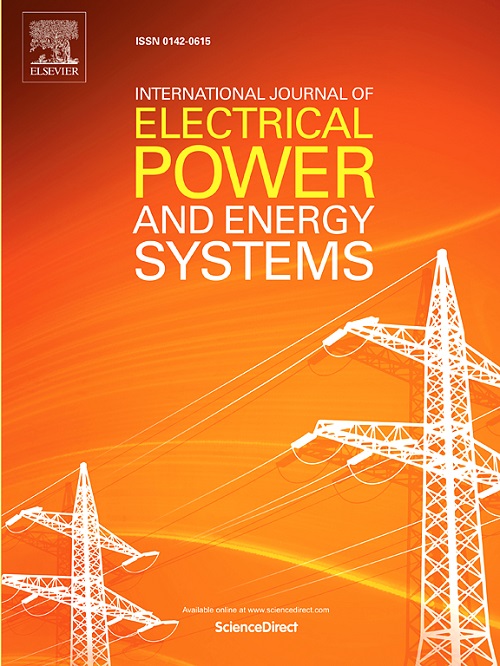Frequency control strategy of microgrid distributed virtual synchronous generator based on asynchronous event triggered communication protocol
IF 5
2区 工程技术
Q1 ENGINEERING, ELECTRICAL & ELECTRONIC
International Journal of Electrical Power & Energy Systems
Pub Date : 2025-04-24
DOI:10.1016/j.ijepes.2025.110666
引用次数: 0
Abstract
Virtual Synchronous Generator (VSG) control technique is a potent solution to the issue of insufficient inertia in power systems. To address the challenges of low inertia and low output impedance in microgrids, this paper proposes a VSG frequency distributed collaborative secondary control strategy and develops a distributed active power sharing control strategy. Initially, considering the frequency parameter discrepancies among individual VSG, a tracking controller for the VSG frequency reference model is designed based on the heterogeneous multi-agent theory. Subsequently, to alleviate the communication overhead, an integral-type event triggering mechanism is constructed. This mechanism obviates the need for a time synchronization system in VSGs, allowing each unit to rely solely on its internal clock for periodic triggering condition assessments. In contrast to the existing VSG secondary control strategies, this approach ensures the efficacy of the distributed secondary control strategy amidst asynchronous communication networks. Furthermore, the stability of the proposed secondary control strategy is demonstrated using the Lyapunov function in conjunction with the event triggering mechanism. Ultimately, an island microgrid system is simulated on the MATLAB/simulink platform, and the simulation results verify the feasibility and effectiveness of the proposed control strategy.
基于异步事件触发通信协议的微电网分布式虚拟同步发电机频率控制策略
虚拟同步发电机(VSG)控制技术是解决电力系统惯性不足问题的有效方法。针对微电网低惯性和低输出阻抗的挑战,提出了VSG频率分布式协同二次控制策略,并开发了分布式有功共享控制策略。首先,考虑到各个VSG之间频率参数的差异,基于异构多智能体理论设计了VSG频率参考模型的跟踪控制器。随后,为了减少通信开销,构造了一种积分型事件触发机制。这种机制消除了对时间同步系统的需要,允许每个单元单独依赖其内部时钟进行周期性触发条件评估。与现有的VSG辅助控制策略相比,该方法保证了分布式辅助控制策略在异步通信网络中的有效性。此外,利用李雅普诺夫函数和事件触发机制证明了所提出的二次控制策略的稳定性。最后,在MATLAB/simulink平台上对孤岛微电网系统进行了仿真,仿真结果验证了所提控制策略的可行性和有效性。
本文章由计算机程序翻译,如有差异,请以英文原文为准。
求助全文
约1分钟内获得全文
求助全文
来源期刊
CiteScore
12.10
自引率
17.30%
发文量
1022
审稿时长
51 days
期刊介绍:
The journal covers theoretical developments in electrical power and energy systems and their applications. The coverage embraces: generation and network planning; reliability; long and short term operation; expert systems; neural networks; object oriented systems; system control centres; database and information systems; stock and parameter estimation; system security and adequacy; network theory, modelling and computation; small and large system dynamics; dynamic model identification; on-line control including load and switching control; protection; distribution systems; energy economics; impact of non-conventional systems; and man-machine interfaces.
As well as original research papers, the journal publishes short contributions, book reviews and conference reports. All papers are peer-reviewed by at least two referees.

 求助内容:
求助内容: 应助结果提醒方式:
应助结果提醒方式:


